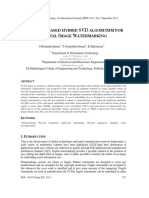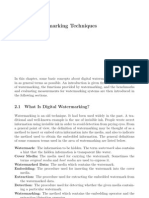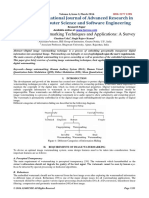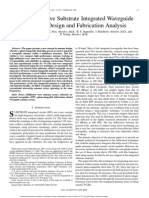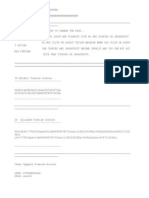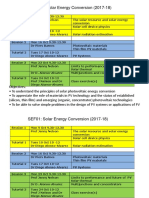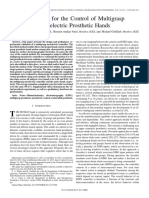Image Watermarking Techniques in Spatial Domain: A Review
Image Watermarking Techniques in Spatial Domain: A Review
Uploaded by
CannyCopyright:
Available Formats
Image Watermarking Techniques in Spatial Domain: A Review
Image Watermarking Techniques in Spatial Domain: A Review
Uploaded by
CannyOriginal Title
Copyright
Available Formats
Share this document
Did you find this document useful?
Is this content inappropriate?
Copyright:
Available Formats
Image Watermarking Techniques in Spatial Domain: A Review
Image Watermarking Techniques in Spatial Domain: A Review
Uploaded by
CannyCopyright:
Available Formats
ISSN:2229-6093
Monika Singla et al, Int. J. Comp. Tech. Appl., Vol 2 (5), 1357-1363
Image Watermarking Techniques in Spatial Domain: A Review
Alankrita Aggarwal Monika Singla
Sr .Assistant Professor Department of M.Tech Student Department of Computer
Computer Science and Engineering ,Haryana Science and Engineering,Haryana Collegeof
College Of Technology and Management, Technology and Management,
Kaithal,India Kaithal,India
alankrita.agg@gmail.com monika.singla160@gmail.com
Abstract
The rapid growth of digital multimedia technologies 1.1. Domain of watermarking
brings tremendous attention to the field of digital The watermarking techniques can be classified into
watermarking. The owner or the distributor of the two categories: spatial domain and transform domain
digital images can insert unique watermark into copies techniques. There definitions are as follow
for different customers or receivers, which will be
helpful to identify the source of illegal copies. 1.1.1. Spatial domain. In spatial domain technique [4],
Watermarking embeds a secret message into a cover [7], [10], [11], [12], [14], the watermark embedding is
multimedia data. In media watermarking the secret is achieved by directly modifying the pixel values of the
usually a copyright notice and the cover a digital host image. The most commonly used method in the
image. In digital watermarking, robustness is still a spatial domain technique is the least significant bit
challenging problem if different sets of attacks needed (LSB). In the least significant bit (LSB) of each pixel in
to be tolerated simultaneously. Many algorithms have the host image was modified to embed the secret
been developed for check the robustness of images In message.
this paper we are reviewing spatial watermarking
technique for digital images like LSB technique, 1.1.2. Transform domain. In transform domain
BLOCK based and Secure watermarking techniques. technique[2],[3]the host image is first converted into
Keywords: Color Image, Spatial Domain, Robust frequency domain by transformation method such as
Watermarking the discrete cosine transform (DCT), discrete Fourier
transform (DFT) or discreet wavelet transform (DWT)
1. Introduction ,etc. then, transform domain coefficients are altered by
A digital watermark is a digital signal or a pattern the watermark. The inverse transform is finally applied
embedded into the host media to be protected, such as in order to obtain the watermarked image. The
an image or audio or video. It contains useful frequency domain methods allow an image to be
certifiable information for the owner of the host media, broken up into different frequency bands. Embedding
such as producer's name, company logo, etc; the the watermark in the low frequency increases the
watermark can be detected or extracted later to make an robustness with respect to image distortions. The high
assertion about the host media. There are two important frequency band of an image is more prone to dropping
properties of a watermark; the first is that the due to quantization and it will be lost by compression
watermark embedding should not alter the quality and or scaling attacks. The middle frequencies embedding
visually of the host image and it should be perceptually of the watermark avoid the most visual important parts
invisible, the second property is robustness with respect of the image and it is robust to compression and noise
to image distortions. This means that the watermark is attacks. There are so many ideas have been proposed
difficult for an attacker to remove and it should be also for placing key inside the binary images or watermark
robust to common image processing and geometric image [10], [4].
operations, such as filtering, resizing, cropping and We discussed a spatial domain block based
image compression. Overviews on image watermarking watermarking scheme, LSB technique and secure
techniques can be found in [1],[2], [5] . watermarking technique. The watermark is a binary
image, which is permuted using a secret key.
IJCTA | SEPT-OCT 2011 1357
Available online@www.ijcta.com
ISSN:2229-6093
Monika Singla et al, Int. J. Comp. Tech. Appl., Vol 2 (5), 1357-1363
2. General framework for digital watermarking watermarking techniques are usually referred to as
secret and public watermarking techniques,
Watermark is a digital signal or pattern inserted into a respectively.
digital data, which can also be referred to as a digital
signature. Watermarking is a key process in the Watermark w
protection of copyright ownership of electronic data, Or original image
Detection
Detection
including image, videos, audio, etc
Text image algorithm Watermark
Any watermarking scheme (algorithm) consists of
Secret/public key
three parts:
(a) The watermark
(b)A watermark embedder (marking insertion
algorithm)
(c)A watermark detector (verification or extraction Figure 2.Generic watermarking recovery scheme
or detection algorithm).
3. Attacks on watermark
2.1. Embedding watermark
The watermark signal, apart from depending on the It is found in the literature that the robust
watermark information W', may also depend on a key watermarking systems proposed so far can only
K and the host data I into which it is embedded, shown withstand some of the possible external attacks but not
in Equation all. The attacks against the watermark try to neutralize
the watermark, without damaging the image too much.
W = f 0(I, K, W) The watermark is neutralized if: (a) the detector cannot
detect the watermark (distortion, attenuation etc.), (b)
the detector cannot recognize the watermark in the
Watermark image from another one, and (c) the watermark is no
longer in the image.In the field of digital watermark,
Digital there are various categorizations of attacks on
Data Watermarking Watermarked watermarks .
Data
3.1. Unintentional attacks
Secret/Public key
3.1.1. Compression. Many compression schemes
Figure 1.Generic watermarking embedded scheme like JPEG and MPEG can potentially degrade the
datas quality through irretrievable loss of data.
2.2. Extracting watermark
Verification algorithm is a design of the 3.1.2.Geometricdistortions. Geometric distortions
corresponding extraction method that recovers the are specific to Images videos and include such
watermark information from the signal mixture, operations as rotation, translation, scaling.
perhaps with the help of the key and the original shown
in Equation (1) or (2) 3.1.3.Common Signal Processing Operations. it
I0 = g (I, I', K) (1) includes D/A conversion, A/D, conversion,
Or without the original Resembling.
I0 = g (I', K) (2)
The input to the scheme is the watermark, the host 3.1.4. Cropping . The watermarked image is cropped
data, and an optional public or secret key. The host data in terms of percentage of image size. The effect of
may, depending on the application, be uncompressed or cropping is decided calculating the NC and SC between
compressed, however, most proposed methods work on extracted watermark and original watermark.
uncompressed data. The watermark can be of any
nature, such as a number, text, or an image. The secret 3.2. Intentional attacks
or public key is used to enforce security. If the 3.2.1 Collusion . A number of authorized recipients of
watermark is not to be read by unauthorized parties, a the image should not be able to come together (collude)
key can be used to protect the watermark. In and like the differently watermarked copies to generate
combination with a secret or a public key, the
IJCTA | SEPT-OCT 2011 1358
Available online@www.ijcta.com
ISSN:2229-6093
Monika Singla et al, Int. J. Comp. Tech. Appl., Vol 2 (5), 1357-1363
an unwatermarked copy of the image (by averaging all Figure 3 Example of Least significant bit watermarking
the watermarked images).
4.2.Secure watermarking scheme for color
3.2.2 Forgery. A number of authorized recipients of
the image should not be able to collude to form a image
copy of watermarked image with the valid of The proposed scheme is of type blind and invisible
embedded watermark of a person not in the group with watermarking. This scheme introduces the concept of
an intention of framing a 3rd party. storing variable number of bits in each pixel based on
the actual color value of pixel. Equal or higher the color
3.2.3. IBM attack. It should not be possible to value of channels with respect to intensity of pixel
produce a fake original that also performs as well as stores higher number of watermark bits. The Red,
the original and also results in the extraction of the Green and Blue channel of the color image has been
watermark as claimed by the holder of the fake original used for watermark embedding. The watermark is
embedded into selected channels of pixel. The
4. Existing techniques proposed method supports high watermark embedding
Image watermarking became popular in the 1990s. capacity, which is equivalent to the size of cover image.
The most important aspect of image watermarking is The security of watermark is preserved by permuting
roubustness. The number of image watermarking the watermark bits using secret key. The algorithm is
techniques has been developed in spatial domain which explained in the following sections.
considered the roubustness. Watermarking methods
differ only in the part or single aspect of three topics 4.2.1 Watermark Embedding.Embedding the
Signal design watermark requires the following steps.
Embedding
Recovery Input: Color (Cover) Image (C) and Monochrome
A Digital image is a 2-D Signal. It Use rectangular Watermark image (W).
shape areas called pixels. Intensity value of pixels are Step 1. Read the watermark image W of size mm
represented as I(X,Y). Here pixel resolution is Step 2. Read a binary key k which is the secret key and
described with the set of two positive integer numbers, compute W'=W K, where is bit wise XOR operator.
where the first number is the number of pixel columns Step 3. Read the color image C of size mm and
(width) and the second is the number of pixel rows. transfer this image into Red (R), Green (G) and Blue
Color image is a combination of three frames i.e. Red, (B) channels of size mm. Then transfer these R, G, B
Green, Blue frames.The first technique in spatial channels into biological color model Hue (H)
domain is tagging technique. A tag is a square of size N Saturation (S) and Intensity (I) using the following
* N. In a first step, all possible locations in an image equations.
where a tag could possibly be placed are identified by if B G
calculating the local region variance of size N * N in H= 360 if B > G (3)
the image and comparing it to empirically identified
upper and lower limits. A selected image area is tagged S= 1- 3 min(R,G, B) (4)
by adding the tag. One selected tag location hides 1 bit
and is only tagged if the bit to embed is set to one. To ( R+G+B)
recover an embedded bit, the difference between the
original and the tagged image is computed.There was (R + G + B)
so many techniques has been introduced .Here we are I= (5)
dicussing some new one which discussed below. 3
Step 4. For each pixel select a channel from R, G, B
4.1. LSB technique which is having value I and embed the watermark bit
The most straightforward method of watermark of W into LSB of selected channels using LSB
embedding would be to embed the watermark into the substitution.
least significant bits of the cover object. Fig. 3.1 shows Step 5. Transfer the modified R, G, B channels into
an example of modifying LSB. watermarked color image C '.
Image: 11001010 00110101 00011010 00000000 ...
Watermark: 1 1 1 0 ... 4.2.2. Watermark Extraction.Algorithm : Watermark
Watermarked 11001011 00110101 00011011 00000000 . Extraction.Input : Watermarked Color Image (C and
the secret key (K).
Image:
IJCTA | SEPT-OCT 2011 1359
Available online@www.ijcta.com
ISSN:2229-6093
Monika Singla et al, Int. J. Comp. Tech. Appl., Vol 2 (5), 1357-1363
Step 1.Read the watermarked color image C of size 32*32 .The Embedding and extraction algorithm is
mm and transfer this image into Red(R '), Green (G') explained in the following sections.
and Blue (B') channels of size mm. Then transfer
these R', G', B' channels into biological color model 4.3.1 Watermark embedding. Step 1. A binary logo
Hue (H'), Saturation (S') and Intensity (I') using the
equations (3), (4) and (5). image is used as the original watermark W of size
Step 2. Read a binary sequence K which is the secret pixels 32*32. The original watermark is permuted to
key. obtain a pseudo random sequence, which uncorrelated
Step 3. For each pixel select a channel from R', G', B' to the original watermark. This is done by performing
which is having value I ' and extract the watermark bit wise EX-OR operation between the original
bit W from LSB of selected channels. watermark bits and random bits, generated using a
Step 4. Process the W ' with key array K to get the secret key, and then the output sequence, is encoded
extracted watermark W as follows: using Gray which code. The permutation process of the
W=W' K, where is bit-wise XOR operator. Watermark W is described as follows:
The performance of extraction algorithm is analyzed Read a binary key k which is the secret key and
by increasing density of the noise compared in terms compute W'=W K, where is bit wise XOR
of NC and SC. The increase in the noise density operator.
reduces the performance of extraction algorithm. The Step 2. The original image H is decomposed into R, G,
watermarked image is cropped in terms of percentage and B components and then the B component is divided
of image size.The proposed watermarking algorithm is into a non-overlapping blocks with size of 8*8 pixels.
robust for cropping on the set of watermarked images. Step 3. Private key is used to determine the positions of
The algorithm is rigid for upto 40 % cropping. The embedding the watermark.
watermarked image is compressed with different Step 4. The encoded watermark W'' is embedded in the
Quality factors. The effect of compression is observed blue component B. For each encoded watermark bit, a
by calculating the NC and SC between extracted block of 8*8 is modified as follows:
watermark and original watermark. As the compression if W''=1;
factor increases the quality of extracted watermark for all the pixels of the 8*8 blocks
decreases. Thus algorithm is robust against {I'=I+ }
compression of quality factor upto 50. Security of If W''=0;
watermark can be further enhanced by using hash For all the pixels of the 8*8 blocks
functions or chaotic binary sequence. The proposed {I'=I- }
algorithm is weak to geometrical transformation. Thus Where I' is the modified pixel intensity and I is the
the future work is to design a geometrical transform- original intensity and is a constant.
invariant watermarking algorithm. Step 5 The modified block of pixels is then positioned
in its original location of the host image and then step 3
4.3. A New robust watermarking scheme for and 4 is repeated until all encoded watermark bits W''
color image in spatial domain are embedded.
A robust watermark scheme based on a block Step 6 After embedding the all encoded watermark bits
probability for color image is presented, which operates four times, the R, G, and B' components are composed
in spatial domain by embedding the watermark image to obtain the watermarked image.
four times in different positions in order to be robust 1 128 384 512
against attack The extraction of the watermark depends
on the original image, so it is a non-blind watermarking Watermark 1
scheme. In the proposed method, the watermark image
is a binary image where as the host image is an 8 bit 128
color image. The four embedded positions are chosen
to hide the watermarks in order to be robust against Watermark3 Watermark4 Waterm3
cropping attack from the bottom, the top or the left or
the right side of the watermarked image. The blue 384
component is chosen to hide the watermark because it
is less sensitive to human eyes. The original color Watermark 2
image H with size of 512*512 pixels, which to be 512
protected by the binary watermark W of size pixels
Fig 4 The proposed watermarks embedded positions
IJCTA | SEPT-OCT 2011 1360
Available online@www.ijcta.com
ISSN:2229-6093
Monika Singla et al, Int. J. Comp. Tech. Appl., Vol 2 (5), 1357-1363
4.3.2 Watermark extraction .The proposed watermark algorithm is rigid for upto 40 % cropping.But in case of
extraction required the original host image and the a New Robust Watermarking Scheme for Color Image
original watermark, therefore, it is a non blind in Spatial Domain,cropping results are better but
watermarking scheme. The steps of watermark algorithm is weak to geometrical transformation attack
extraction are described below. such as rotation, translation, scaling.To get better result
Step 1. The proposed extraction is based on the in case of noise attack,we can place watermark at five
probability (P1, P0) of detecting '1' or '0' bit, which different positions and used another image as a key in
can be obtained by comparing each pixel (I') in a block watermark to increase security .
of 8*8 of the watermarked image with the
corresponding pixel (I) in the original image and then 6. References
the probability is calculated as follows: [1] W. Bender,D.Gruhl,N.Mormoto, and A.Lu,Techniques
P1=P1+1/64 if I' > I for data hiding, IBM Systems Journal, vol. 35, no 3 pp 313-
P0=P0+1/64 if I' I 336, 1996.
Step 2. According to the probability (P1, P0), the [2] F. Hartung and M. Kutter, "Multimedia watermarking
extracted watermark bits W'' can be decoded as techniques," Proceedings of the IEEE, vol. 87, pp. 1079-
follows: 1107, 1999
W = 1 if P1 P0 [3] Hsiang-Kuang Pan, Yu-Yuan Chen, and Yu-Chee Tseng,
A Secure Data Hiding Scheme for Two-Color Images, in
W = 0 if P1< P0 Fifth IEEE Symposium on Computers and Communications,
Step 3. The extracted watermark bits for the four pp. 750 755, July 2000.
watermarks are decoded using Gray code and then, the [4] M. Wu, E. Tang, and B. Liu, Data hiding in digital
decoded bits are XOR with random bits, which binary image, Electrical Engineering Dept., Princeton Univ.,
generated using the same secret key that was used Princeton, NJ 08544,Electrical & Computer Engineering
during the watermark embedding. The decoded Dept., John Hopkins Univ., Baltimore, MD 21218 in Proc. Of
watermarks bits are reordering to images W'1, W'2, IEEE Int. Conf. on Multimedia and Expo, New York City,
W'3, W'4. pp. 393-396, July 31 to August 2, 2000
Step 4. we calculate the normalized cross correlation [5] G. C. Langelaar, I. Setyawan, and R. L.
Lagendijk,"Watermarking digital image and video data. A
between the original watermark image W and the state of the-art overview," Signal Processing Magazine,IEEE,
extracted watermarks W'1, W'2, W'3, W'4 to make a vol. 17, pp. 20-46, 2000.
binary decision on whether a given watermark exists or [6] H.Ren-Junn, K. Chuan-Ho, and C. Rong-Chi, "Watermark
not. We choose 0.5 as the threshold for watermark in color image," Proceedings of the first International
decision. Symposium on Cyber Worlds, pp. 225-229, 2002.
Step 5. The normalized cross correlation is defined by [7] S. Kimpan, A. Lasakul, and S. Chitwong,"Variable block
Wi jW'i j size based adaptive watermarking in spatial domain,"
i j presented at Communications and Information Technology,
NCC= ISCIT 2004. IEEE International Symposium on, vol. 1, pp.
374-377, 2004.
(Wij)2 [8] Feng-Hsing Wang, Lakhmi C. Jain, Jeng-Shyang Pan,
i j Hiding Watermark in Watermark, in IEEE International
Where W i j and W' i j are the pixel values at the Symposium in Circuits and Systems (ISCAS) ,Vol. 4, pp.
position (i, j) of the original and the extracted 4018 4021, May 2005
watermark. This scheme is highly robust against [9] Juan Jose Roque, Jesus Maria Minguet SLSB: Improving
various of image processing operations such as, the Steganographic Algorithm LSB Universidad Nacional de
filtering, cropping, scaling, compression, rotation, Educacin a Distancia, 2006.
randomly removal of some rows and columns lines and [10] B. Verma, S. Jain, D. P. Agarwal, and A.Phadikar, "A
salt and paper noise. New color image watermarking scheme," Info comp, Journal
of computer science , vol. 5,No.2, pp. 37-42, 2006.
[11] X. Wu and Z.-H. Guan, "A novel digital watermark
5. Conclusion algorithm based on chaotic maps," Department of Control
Science and Engineering, Huazhong University of Science
In this paper, spatial domain watermarking techniques and Technology, Wuhan, Hubei 430074, PR Chinab School
for color Images are discussed .LSB is proved to be of Electronics and information, Yangtze University,
simple and powerful tools for Steganography but lack Jingzhou, Hubei 434023, PR China, Science Direct, Physics
the robustness.In case of secure watermarking Letters A, vol. 365, pp. 403-406, 2007.
technique, the security of watermark is preserved by [12] Ibrahim Nasir, Ying Weng, Jianmin Jiang, A New
permuting the watermark bits using secret key. The Robust Watermarking Scheme for Color Image in Spatial
increase in the noise density and compression factor Domain, School of Informatics, University of Bradford, UK
reduces the performance of extraction algorithm. The 2008.
IJCTA | SEPT-OCT 2011 1361
Available online@www.ijcta.com
ISSN:2229-6093
Monika Singla et al, Int. J. Comp. Tech. Appl., Vol 2 (5), 1357-1363
[13] Nagaraj V. Dharwadkar and B. B. Amberker ,Secure
Watermarking Scheme for Color Image Using Intensity of
Pixel and LSB Substitution, journal of computing, volume 1,
issue 1, ISSN: 2151-9617, December 2009 .
[14] V.Madhu Viswanatham, Jeswanth Manikonda, Novel
Technique for Embedding Data in Spatial Domain ,School
of Computing Science and Engineering, VIT University,
Vellore, India, International Journal on Computer Science
and Engineering Vol. 2pp.233-236,2010.
IJCTA | SEPT-OCT 2011 1362
Available online@www.ijcta.com
ISSN:2229-6093
Monika Singla et al, Int. J. Comp. Tech. Appl., Vol 2 (5), 1357-1363
IJCTA | SEPT-OCT 2011 1363
Available online@www.ijcta.com
You might also like
- Digital Watermarking: A TutorialDocument12 pagesDigital Watermarking: A TutorialCyberJournals MultidisciplinaryNo ratings yet
- Grayscale Image Watermark DetectionDocument7 pagesGrayscale Image Watermark DetectionMurilo Vasconcelos AndradeNo ratings yet
- Ijset 2014 803Document4 pagesIjset 2014 803Editorijset IjsetNo ratings yet
- Robust Image Watermarking Theories and Techniques: A Review: Vol.12, February2014Document17 pagesRobust Image Watermarking Theories and Techniques: A Review: Vol.12, February2014evergreenman55No ratings yet
- A Survey Work On Digital WatermarkingDocument4 pagesA Survey Work On Digital WatermarkingNguyễn Văn Hùng DũngNo ratings yet
- Digital Image Watermarking Using 3 Level Discrete Wavelet TransformDocument5 pagesDigital Image Watermarking Using 3 Level Discrete Wavelet Transformtjdandin1No ratings yet
- 7.1 Classification of Digital Watermarking TechniquesDocument30 pages7.1 Classification of Digital Watermarking TechniquesLong Đào HảiNo ratings yet
- A Review On Digital Image Watermarking Using 3-Level Discrete Wavelet TransformDocument7 pagesA Review On Digital Image Watermarking Using 3-Level Discrete Wavelet TransformShahid RanaNo ratings yet
- Ijcet: International Journal of Computer Engineering & Technology (Ijcet)Document12 pagesIjcet: International Journal of Computer Engineering & Technology (Ijcet)IAEME PublicationNo ratings yet
- Digital Watermarking TrendsDocument7 pagesDigital Watermarking TrendsWhite Globe Publications (IJORCS)No ratings yet
- Image Authentication Subject ReviewDocument6 pagesImage Authentication Subject Revieweditor ijeratNo ratings yet
- Ijct V2i6p5Document11 pagesIjct V2i6p5IjctJournalsNo ratings yet
- Digital Watermarking in Wavelet Transform DomainDocument5 pagesDigital Watermarking in Wavelet Transform Domainkhaja mizbahuddin quadryNo ratings yet
- Ijaiem 2014 06 04 1Document6 pagesIjaiem 2014 06 04 1International Journal of Application or Innovation in Engineering & ManagementNo ratings yet
- Digital Watermarking: A TutorialDocument12 pagesDigital Watermarking: A TutorialJiawei LinNo ratings yet
- Wavelet Based Watermarking Technique Using Simple Preprocessing MethodsDocument5 pagesWavelet Based Watermarking Technique Using Simple Preprocessing Methodsvol1no2No ratings yet
- Study of 5 Level DWT and Comparative Performance Analysis of Digital Video Watermarking Techniques Using 3-L-DWT and 5-L-DWTDocument7 pagesStudy of 5 Level DWT and Comparative Performance Analysis of Digital Video Watermarking Techniques Using 3-L-DWT and 5-L-DWTerpublicationNo ratings yet
- DCT Based Video Watermarking in MATLAB PDFDocument11 pagesDCT Based Video Watermarking in MATLAB PDFKamlesh DahiyaNo ratings yet
- Ijert Ijert: VLSI Implementation of Digital Image WatermarkingDocument6 pagesIjert Ijert: VLSI Implementation of Digital Image WatermarkingVenkataramanLakshminarayananNo ratings yet
- Ijrte Wavelet PDFDocument4 pagesIjrte Wavelet PDFKamau GabrielNo ratings yet
- Synopsis of Digital WatermarkingDocument15 pagesSynopsis of Digital WatermarkingAryan MehraNo ratings yet
- Digital Water Mark 2-9Document19 pagesDigital Water Mark 2-9Sandip AjmireNo ratings yet
- Anjaneyulu Base PaperDocument28 pagesAnjaneyulu Base PaperRevanthkumarNo ratings yet
- Compusoft, 2 (4), 97-102Document6 pagesCompusoft, 2 (4), 97-102Ijact EditorNo ratings yet
- FingerprintDocument4 pagesFingerprintmmarosaNo ratings yet
- A Survey: Digital Image Watermarking TechniquesDocument14 pagesA Survey: Digital Image Watermarking Techniquesvidhyasree123No ratings yet
- Digital WatermarkingDocument19 pagesDigital WatermarkingsruthiNo ratings yet
- Hybrid Robust Watermarking Technique Based On DWT, DCT and SVDDocument7 pagesHybrid Robust Watermarking Technique Based On DWT, DCT and SVDmujtaba21No ratings yet
- A Novel Digital Watermarking Technique For Video Copyright ProtectionDocument9 pagesA Novel Digital Watermarking Technique For Video Copyright ProtectionCS & ITNo ratings yet
- Dual Image Watermarking Scheme Based On DWT-SVD: D. M. Gaikwad A. R. KarwankarDocument6 pagesDual Image Watermarking Scheme Based On DWT-SVD: D. M. Gaikwad A. R. Karwankarrahul sharmaNo ratings yet
- Earth and Atmospheric SciencesDocument6 pagesEarth and Atmospheric Sciencesp.maheswariopenventioNo ratings yet
- Digital WatermarkingDocument6 pagesDigital WatermarkingMa SeenivasanNo ratings yet
- Digital Image Watermarking Using Deep Learning - A SurveyDocument12 pagesDigital Image Watermarking Using Deep Learning - A SurveyMan EbookNo ratings yet
- DCT-DWT Based Digital Watermarking and Extraction Using Neural NetworksDocument5 pagesDCT-DWT Based Digital Watermarking and Extraction Using Neural Networkshmm raniaNo ratings yet
- Digital Water MarkingDocument6 pagesDigital Water Markingsiri831No ratings yet
- A Wavelet Based Hybrid SVD Algorithm For Digital Image WatermarkingDocument18 pagesA Wavelet Based Hybrid SVD Algorithm For Digital Image WatermarkingsipijNo ratings yet
- Digital Water MarkingDocument7 pagesDigital Water Marking4ndr01d0n3No ratings yet
- A Review Paper On Digital WatermarkingDocument7 pagesA Review Paper On Digital WatermarkingInternational Journal of Application or Innovation in Engineering & ManagementNo ratings yet
- A Review On Different Digital Watermarking TechniquesDocument6 pagesA Review On Different Digital Watermarking TechniquesInternational Journal of Innovative Science and Research TechnologyNo ratings yet
- Progress Report On Digital WatermarkingDocument34 pagesProgress Report On Digital WatermarkingRejina Shakya100% (3)
- Medical Image WatermarkingDocument10 pagesMedical Image Watermarkinga.enstticNo ratings yet
- Hurrah 2017Document5 pagesHurrah 2017ناصرھرەNo ratings yet
- An Imperceptible Blind Image Watermarking Scheme For Image Authentication Using DNA Encoding and Multi-Resolution Wavelet DecompositionDocument8 pagesAn Imperceptible Blind Image Watermarking Scheme For Image Authentication Using DNA Encoding and Multi-Resolution Wavelet DecompositionInternational Journal of Engineering Inventions (IJEI)No ratings yet
- VLSI Implementation of Online Digital Watermarking Technique With Difference Encoding For 8-Bit Gray Scale ImagesDocument6 pagesVLSI Implementation of Online Digital Watermarking Technique With Difference Encoding For 8-Bit Gray Scale ImagesMOHAMMAD AWAISNo ratings yet
- Fragile Invisible Watermark Technique: Y.Parvathi B.tech, C.S.E (2 Yr.) RGMC of Engineering & Technology, Nandyal E-MailDocument10 pagesFragile Invisible Watermark Technique: Y.Parvathi B.tech, C.S.E (2 Yr.) RGMC of Engineering & Technology, Nandyal E-MailSai Kiran VemulaNo ratings yet
- Ijcet: International Journal of Computer Engineering & Technology (Ijcet)Document8 pagesIjcet: International Journal of Computer Engineering & Technology (Ijcet)IAEME PublicationNo ratings yet
- Must ReadDocument16 pagesMust ReadSheela ShivaramNo ratings yet
- Recent Water1Document8 pagesRecent Water1Jeet SharmaNo ratings yet
- Visual CryptographyDocument9 pagesVisual Cryptographydivyaruchi23No ratings yet
- 1.1 Overview of The Project: Data Hiding Can Be Defined As The Process by Which A Message Signals or Image IsDocument49 pages1.1 Overview of The Project: Data Hiding Can Be Defined As The Process by Which A Message Signals or Image IssamNo ratings yet
- Image Authentication: Keywords: Watermark, Transform Domain, DCT, FFT, Picture CroppingDocument9 pagesImage Authentication: Keywords: Watermark, Transform Domain, DCT, FFT, Picture Croppingapi-26172869No ratings yet
- Ijmecs V4 N3 7 PDFDocument7 pagesIjmecs V4 N3 7 PDFashalizajohnNo ratings yet
- A Semi-Blind Reference Video Watermarking Using: Satyanarayana Murty. P K. Venkatesh Rajesh Kumar. PDocument11 pagesA Semi-Blind Reference Video Watermarking Using: Satyanarayana Murty. P K. Venkatesh Rajesh Kumar. PMaharani MeidyNo ratings yet
- Video Watermarking Using Wavelet TransformationDocument4 pagesVideo Watermarking Using Wavelet TransformationseventhsensegroupNo ratings yet
- Machine Learning BasedDocument7 pagesMachine Learning Basedraciv46361No ratings yet
- International Journal of Computational Engineering Research (IJCER)Document4 pagesInternational Journal of Computational Engineering Research (IJCER)International Journal of computational Engineering research (IJCER)No ratings yet
- 10.1007@978 3 319 23950 77 PDFDocument30 pages10.1007@978 3 319 23950 77 PDFDinh Hoang OanhNo ratings yet
- An Improved Robust Watermarking TechniqueDocument4 pagesAn Improved Robust Watermarking TechniqueCHARANNo ratings yet
- A Quick Glance at Digital Watermarking in Medical Images Technique Classification, Requirements, Attacks and Application of Tamper LocalizationDocument6 pagesA Quick Glance at Digital Watermarking in Medical Images Technique Classification, Requirements, Attacks and Application of Tamper LocalizationH KingNo ratings yet
- Year 7 Graphic Score 3Document12 pagesYear 7 Graphic Score 3Jason MitchellNo ratings yet
- Siw AntennaDocument8 pagesSiw Antennasayantan100% (1)
- IEEE Guide For Protective RelayDocument141 pagesIEEE Guide For Protective RelayLuis Ignacio Sánchez100% (7)
- Bosch Malaysia Power Tools 2011Document118 pagesBosch Malaysia Power Tools 2011Irwan AliasNo ratings yet
- 757-4002-383 Nexcom715Document10 pages757-4002-383 Nexcom715Admir Talic100% (1)
- Cortex™ M3Document384 pagesCortex™ M313579krmyNo ratings yet
- Swot Analysis Blue DartDocument5 pagesSwot Analysis Blue DartIndranil DuttaNo ratings yet
- Epson C1600 OKI C110 160 XRX 6121 Reset Kit Manual 2Document1 pageEpson C1600 OKI C110 160 XRX 6121 Reset Kit Manual 2Young ParkNo ratings yet
- Aurora: PVM (X) SeriesDocument36 pagesAurora: PVM (X) Seriesmochamad azzumarNo ratings yet
- Rms Reject PDFDocument1 pageRms Reject PDFssrvnnNo ratings yet
- 100% Working-Premium Accounts and Cookies - 24 July 2012Document14 pages100% Working-Premium Accounts and Cookies - 24 July 2012butoijoNo ratings yet
- Load Test On Piles-ReportDocument13 pagesLoad Test On Piles-ReportChowdhury PriodeepNo ratings yet
- Air Pollution Dispersion Modeling PDFDocument6 pagesAir Pollution Dispersion Modeling PDFadcaNo ratings yet
- Bates V Post Office: Steve Parker Witness Statement 2Document13 pagesBates V Post Office: Steve Parker Witness Statement 2Nick WallisNo ratings yet
- Livia Catalogue PDFDocument7 pagesLivia Catalogue PDFJessa AnnaNo ratings yet
- Hreinn ThormarDocument17 pagesHreinn ThormarJyothi RameshNo ratings yet
- Method Statement Raub EditDocument10 pagesMethod Statement Raub EditMohd HafizNo ratings yet
- SEF01: Solar Energy Conversion (2017-18)Document76 pagesSEF01: Solar Energy Conversion (2017-18)Duncan ReeceNo ratings yet
- MSS SP-71 1997 Gray Iron Check ValvesDocument10 pagesMSS SP-71 1997 Gray Iron Check ValvesmadhunikhilNo ratings yet
- A Method For The Control of Multigrasp Myoelectric Prosthetic HandsDocument10 pagesA Method For The Control of Multigrasp Myoelectric Prosthetic HandsSahana RangarajanNo ratings yet
- AHSE01 HSE Manual Issue1 Rev 01Document26 pagesAHSE01 HSE Manual Issue1 Rev 01Ali Zafar100% (1)
- 373 Lecture 1Document35 pages373 Lecture 1api-3696125No ratings yet
- Rotavator Multipurpose Tillage ImplementDocument12 pagesRotavator Multipurpose Tillage ImplementkhetiGaadiNo ratings yet
- TAS TRL Document 1.4Document33 pagesTAS TRL Document 1.4NugrohoNo ratings yet
- 12 Step Goal-Setting Process: Brian TracyDocument29 pages12 Step Goal-Setting Process: Brian TracyAnsarMahmood100% (1)
- tm5 809 6Document27 pagestm5 809 6PDHLibraryNo ratings yet
- Fake Companies ListDocument17 pagesFake Companies ListkkkrajaNo ratings yet
- Form 1 science is in English. OK?????: 我们参考的 posterDocument3 pagesForm 1 science is in English. OK?????: 我们参考的 posterTan Soong WeiNo ratings yet
- PDF Burj KhalifaDocument18 pagesPDF Burj Khalifajohncena777100% (1)
- Isolator SizingDocument28 pagesIsolator SizingInzamamNo ratings yet



































